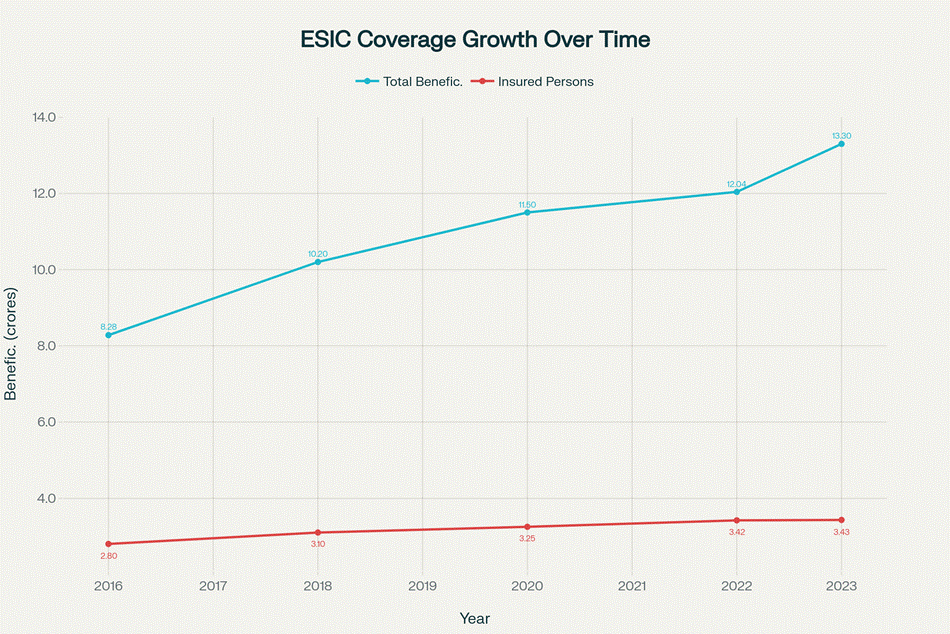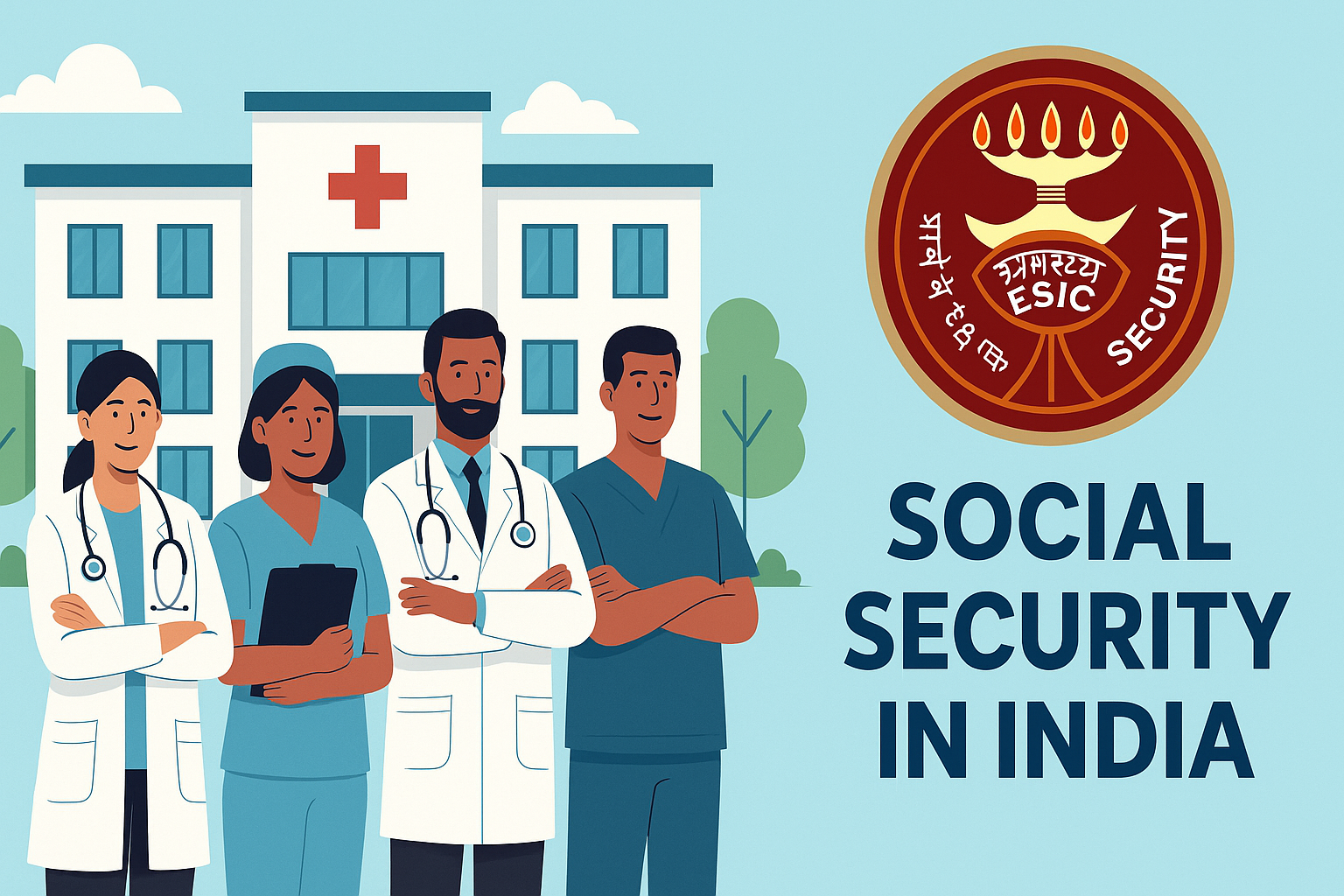Employees’ State Insurance Corporation: India’s Premier Social Security Institution
The Employees’ State Insurance Corporation (ESIC) stands as one of India’s most significant social security institutions, providing comprehensive healthcare and cash benefits to millions of workers and their families across the organized sector. Established under the Employees’ State Insurance Act of 1948, ESIC represents India’s first major step toward creating a robust social security framework for industrial workers in post-independence India. As of March 2023, the scheme covers 3.43 crore insured persons with 13.30 crore total beneficiaries, making it one of the world’s largest contributory social security schemes. This comprehensive system provides medical care, maternity benefits, disability support, and unemployment assistance, contributing to India’s overall social protection coverage which has increased from 24.4% in 2021 to 48.8% in 2024 according to the International Labour Organization. [1][2][3][4][5][6][7]

Growth in ESIC Coverage: Total Beneficiaries and Insured Persons (2016-2023)
Historical Foundation and Legislative Framework
Genesis and Early Development
The origins of ESIC trace back to the pre-independence era when Bhalchandra Pundarik (BP) Adarkar was appointed by the Government of India in March 1943 to create a comprehensive report on health insurance schemes for industrial workers. This foundational study became the basis for the Employment State Insurance (ESI) Act of 1948, which was among the first major social security legislation enacted by independent India’s Parliament. The legislation reflected the newly independent nation’s commitment to protecting workers against financial distress arising from sickness, maternity, temporary or permanent disability, and employment-related injuries or death.[2][3]
The scheme was officially inaugurated on February 24, 1952, at Kanpur by Prime Minister Pandit Jawaharlal Nehru, who became the first honorary insured person under the scheme. The inaugural ceremony at Brijender Swarup Park witnessed a gathering of 70,000 people and was simultaneously launched in Delhi, with initial coverage extending to 1.2 lakh employees across both centers. This historic moment marked the beginning of India’s journey toward comprehensive social security for organized sector workers.[3][2]
Legal Structure and Statutory Basis
The Employees’ State Insurance Act of 1948 established ESIC as a statutory autonomous corporate body under the Ministry of Labour and Employment. The Act grants ESIC significant powers as a legal entity, including the authority to raise loans with prior government sanction, acquire movable and immovable property, and establish medical infrastructure either independently or in collaboration with state governments. The legislation has undergone several amendments to expand coverage and modernize operations, with the most recent significant changes occurring under the Code on Social Security, 2020. [8][3][9][10][11]
The Act initially focused on factory workers but has gradually expanded its definition of covered establishments to include motor road transport, hotels, cinemas, newspaper establishments, shops, private medical and educational institutions. This evolution reflects the changing nature of India’s economy and the recognition that social security protection must adapt to encompass diverse forms of employment.[12]
Coverage and Eligibility Criteria
Geographic and Sectoral Coverage
ESIC’s geographic reach has expanded dramatically from its modest beginnings in two centers to a comprehensive national presence. As of 2024, the ESI Scheme is implemented across 668 districts in 36 states and union territories, including 565 fully notified districts and 103 partially notified districts. The scheme remains to be extended to 135 districts, indicating ongoing expansion efforts to achieve complete national coverage.[13]
The eligibility threshold varies by state, with most requiring establishments employing 10 or more persons to mandatorily register under the scheme, while some states maintain a threshold of 20 employees. The wage ceiling for coverage, effective from January 1, 2017, is Rs. 21,000 per month (Rs. 25,000 for persons with disabilities). This relatively broad coverage ensures that a significant portion of India’s organized workforce benefits from social security protection.[1][14][8][13]
Employment Categories and Sectors
The scheme encompasses a diverse range of employment sectors, including:
- Manufacturing and Factory Workers: Traditional industrial establishments with 10 or more employees
- Service Sector: Shops, hotels, restaurants, and commercial establishments
- Transportation: Road transport undertakings and related services
- Entertainment Industry: Cinemas and entertainment establishments
- Educational and Medical Institutions: Private schools, colleges, and healthcare facilities
- Construction Workers: Extended to construction sites in implemented areas since August 2015[2]
- Emerging Sectors: The Code on Social Security, 2020 envisions extending coverage to gig workers, platform workers, and other non-traditional employment categories[9][15]
This sectoral diversity reflects ESIC’s evolution from a scheme focused primarily on industrial workers to a comprehensive social security system addressing the needs of India’s diverse workforce.
Benefits and Services Structure
ESIC provides six primary categories of benefits as outlined in Section 46 of the ESI Act, 1948, creating a comprehensive safety net for insured workers and their families.[3][16]

Distribution of ESIC Benefit Utilization by Type
Medical Benefits
Medical benefits constitute the largest component of ESIC services, accounting for approximately 80.5% of total benefit utilization. The medical care system operates through:[17]
Primary Healthcare Infrastructure: ESIC operates 1,574 dispensaries, including 36 directly managed by the corporation and 1,466 run by states under the ESI scheme. Additionally, 89 Dispensary-cum-Branch Offices (DCBOs) provide integrated medical and administrative services.[18]
Secondary and Tertiary Care: The network includes 160 hospitals across India, comprising 53 directly operated by ESIC and 107 managed by state governments under the ESIS framework. These facilities provide comprehensive medical services including medicine, surgery, gynecology and obstetrics, orthopedics, and pediatrics.[19][20][18]
Specialized Services: ESIC has established five Occupational Disease Centers in Mumbai, New Delhi, Kolkata, Chennai, and Indore for early detection and treatment of work-related health conditions. Additionally, tie-up arrangements with over 1,000 private hospitals ensure access to specialized care when in-house services are unavailable.[2][12][20]
Cash Benefits
Sickness Benefit: Provides 70% of daily wages for a maximum of 91 days during periods of illness-related absence from work, available in two consecutive periods within a year.[21][2][3]
Maternity Benefit: Offers 100% of daily wages for 26 weeks (up to two surviving children), with a maximum of 8 weeks preceding delivery. For the third child and subsequent births, the benefit period is reduced to 12 weeks. The scheme also provides 6 weeks of benefit in cases of miscarriage and 12 weeks for adoption.[22][23][21]
Disablement Benefit:
- Temporary Disablement: 90% of monthly wages until recovery
- Permanent Disablement: 90% of monthly wages for life, calculated based on the degree of earning capacity loss[2][21]
Unemployment Benefit: Under the Atal Beemit Vyakti Kalyan Yojana, provides 50% of average monthly wages for up to 24 months in cases of involuntary unemployment or permanent invalidity.[24]
Dependent Benefit: Provides 90% of wages to dependents in case of the insured person’s death due to employment injury.[21][2]
Funeral Expenses: Rs. 15,000 toward funeral costs, disbursed within 2-3 days to support bereaved families.[21]
Ancillary Services
Vocational Rehabilitation: Training programs for permanently disabled workers to facilitate reintegration into the workforce.[21][2]
Physical Rehabilitation: Free assistive devices and rehabilitation services for workers who have suffered limb loss or functional impairment due to workplace injuries.[21]
Confinement Benefit: Coverage for delivery expenses when required medical care is not available locally.[21]
Superannuation Benefits: Rs. 120 per annum for retired insured persons and their spouses.[21]
Administrative Structure and Governance
Organizational Hierarchy
ESIC operates through a well-defined administrative structure designed to ensure efficient service delivery across India’s diverse geographic and demographic landscape. The Union Minister of Labour and Employment serves as Chairman of ESIC, while the Director General functions as the Chief Executive Officer. This structure ensures high-level political oversight while maintaining operational autonomy.[8][3]
The corporation comprises representatives from crucial stakeholder groups including employers, employees, central and state governments, Parliament members, and medical professionals. This multi-stakeholder approach ensures that diverse perspectives inform policy decisions and operational strategies.[8]
Regional Organization
ESIC’s administrative network is organized into five zones headed by Zonal Medical Commissioners and Zonal Insurance Commissioners. Each state typically has one Regional Office (RO) headed by an Additional Commissioner or Director-level officer, with further subdivision into Sub-Regional Offices (SROs) covering multiple districts. This decentralized structure enables localized service delivery while maintaining national coordination.[3]
The operational framework includes:
- 65 Regional and Sub-Regional Offices distributed across states
- 628 Branch Offices and 185 Pay Offices for cash benefit disbursement
- 62 Regional/Sub-Regional and Divisional Offices providing supervisory functions[2]
Governance and Accountability
The Medical Benefit Council, a specialized advisory body, provides guidance on medical benefit administration. This technical expertise ensures that medical services align with contemporary healthcare standards and best practices. State Medical Officers (SMO) and Medical Vigilance Officers (MVO) posted in zonal and regional offices oversee medical administrative functions.[8][3]
Recent governance enhancements include the formation of state ESI societies to provide states with greater financial and administrative autonomy for medical service improvements. This decentralization initiative aims to enhance responsiveness to local healthcare needs while maintaining national standards.[18][19]

Front view of an Employees’ State Insurance Corporation (ESIC) Hospital building in India.
Digital Transformation and Modernization Initiatives
E-Pehchan Card System
ESIC has undertaken significant digitization efforts, most notably through the introduction of the e-Pehchan card system under Project Panchdeep. This smart card initiative represents a major advancement in service delivery, replacing the earlier biometric-based system with a more accessible digital alternative.[3][25][26]
The e-Pehchan card contains comprehensive information including:
- Personal details of the insured person
- Employment information and employer details
- Family member information for dependent coverage
- QR codes for digital verification and authentication
- Links to designated dispensaries and healthcare providers[25]
Digital Service Delivery
The Ministry of Labour and Employment has mandated immediate issuance of e-Pehchan cards to all newly registered employees, with Regional and Sub-Regional Offices instructed to ensure both digital and hard copy distribution. This dual approach accommodates varying levels of technological literacy while promoting digital adoption.[27]
The digitization initiative includes:
- Online Registration and Card Generation: Employers can download e-Pehchan cards directly from the ESI Portal
- UMANG Platform Integration: Services are available through the government’s unified mobile application platform[28]
- Digital Health Passbooks: Electronic maintenance of medical records and treatment history
- Mobile-Based Services: Two-minute card download process using mobile phones
Information Technology Infrastructure
Despite significant progress, IT infrastructure challenges persist across the network. Internal assessments identify issues including non-functioning Dhanwantri modules, poor internet connectivity, and inadequate digital infrastructure in remote areas. The Common Support Mission framework has been established to address these challenges through systematic infrastructure upgrades and technical support.[17]
Financial Performance and Sustainability
Revenue Structure and Contribution Mechanism
ESIC operates as a self-financing scheme funded primarily through employer and employee contributions. The current contribution rates, effective from July 1, 2019, are: [8]
- Employee Contribution: 0.75% of wages
- Employer Contribution: 3.25% of wages
- Total Contribution: 4% of wages [14][8]
Employees earning less than Rs. 176 per day are exempted from contribution payments, though employers must continue their contributions. State governments bear 1/8th of medical benefit costs, providing additional financial support to the scheme. [14][8]
Budget Estimates and Financial Planning
The ESI Corporation’s budget for 2024-25 projects significant financial growth. Contribution income is estimated at Rs. 229,680 crore for 2024-25, representing substantial improvement over previous years. The revised estimates for 2023-24 project contribution income of Rs. 208,800 crore, indicating strong revenue collection performance.[29]
Investment and Surplus Management
ESIC maintains substantial investment reserves, with cumulative investments of Rs. 1,35,998 crore as of March 31, 2023. This includes Rs. 1,15,101 crore with investment portfolio managers and Rs. 20,885 crore in special deposits with the central government. These surplus funds have generated considerable debate regarding optimal utilization for beneficiary services.[12]
The investment strategy has evolved from earlier attempts to establish 16 medical colleges (later reduced to 6 due to implementation challenges) to more focused infrastructure development and service improvement initiatives. Current priorities include hospital capacity expansion, medical college establishment, and healthcare infrastructure modernization.[12]
Infrastructure Development and Medical Services
Healthcare Network Expansion
ESIC has approved establishment of 105 new hospitals nationwide to address growing demand for medical services. This expansion includes both ESIC-operated facilities and state-run ESI scheme hospitals. The corporation has also approved 10 new ESIC Medical Colleges in locations including Andheri (Maharashtra), Basaidarapur (Delhi), Guwahati (Assam), and other strategic locations.[19][24]
Medical Education and Human Resources
The medical education initiative includes:
- ESIC Medical Colleges: Operating colleges in multiple states with approved expansion to 10 additional institutions
- Nursing and Paramedical Programs: B.Sc. Nursing and paramedical courses at ESIC Medical Colleges in Alwar, Bihta, Faridabad, and other locations[24]
- NORCET Recruitment: Adoption of AIIMS-aligned nursing officer recruitment through NORCET to address staffing shortages[24]
Ayush Integration
ESIC has approved establishment of Ayush units in hospitals and dispensaries where average daily allopathic OPD registration exceeds 150 patients over 12 months. Fifty-bed ESIC Ayush hospitals are being co-located with existing ESI allopathic hospitals having 500 or more beds. This integration reflects India’s commitment to traditional medicine systems alongside modern healthcare.[19]
Infrastructure Quality and Standards
Recent infrastructure improvements include:
- Enhanced Bed Capacity: 50% bed strength increases in facilities with over 70% occupancy for three consecutive years[18][19][20]
- Staff Strength Enhancement: Implementation of new staffing norms for ESIC hospitals
- Specialized Equipment: Installation of modern medical equipment including operation theater complexes, intensive care units, and imaging services[19]
- Central Sterile Supply: Establishment of CSSD/TSSU facilities to ensure sterile supply chains[19]
Challenges and Implementation Issues
Service Delivery Gaps
Research and internal assessments identify significant challenges in benefit delivery despite substantial financial resources. The central problem appears to be poor service disbursement rather than inadequate funding, with very low utilization rates for cash benefits. For instance, only 0.09 cash benefits per employee per annum (approximately one in ten) received any cash benefit during recent assessment periods.[12]
Infrastructure and Administrative Constraints
Key implementation challenges include:
Infrastructural Issues: Delays in land allotment, poor utilization of available land, inadequate buildings, and poor maintenance of existing facilities.[17]
Equipment and Supply Chain Problems: Non-availability of essential medical equipment, particularly in newly constructed facilities, and supply chain issues affecting medicines, kits, reagents, and consumables.[17]
Human Resource Shortages: Acute shortages of doctors, nurses, and paramedical staff across the network.[17]
Administrative Inefficiencies: Poor fund utilization by states, inadequate planning and monitoring by ESI Corporation, and bureaucratic obstacles in recruitment and procurement.[12][17]
Systemic and Governance Issues
Accessibility and Convenience: Inconvenient facility timings, particularly for chronic illness management, excessive paperwork, unfamiliarity with systems among workers, and lack of support services.[12]
Bureaucracy and Corruption: Persistent issues with bureaucratic delays and corruption affecting service delivery.[12]
Cultural Attitudes: Despite premium payments by workers, there appears to be institutional reluctance to provide benefits, with services sometimes treated as charity rather than entitlements.[12]
Recent Reforms and Policy Developments
Code on Social Security, 2020
The enactment of the Code on Social Security, 2020 represents the most significant reform in India’s social security landscape since independence. This comprehensive legislation consolidates 29 existing laws into four labor codes, with the Social Security Code specifically incorporating the ESI Act, 1948 while expanding ESIC’s mandate.[9][10][11][30]
Key provisions of the new framework include:
Expanded Coverage: Extension to gig workers, platform workers, unorganized sector workers, and plantation workers. The code allows voluntary registration where employers and majority employees agree, and enables government extension to any hazardous occupation with even a single employee.[15][9]
Enhanced Protections: Requirement for ESIC to provide benefits even when employers fail to pay contributions, with recovery mechanisms to reclaim costs from defaulting employers.[9]
Geographic Expansion: ESI facilities to be available across all 740 districts.[9]
Flexible Implementation: States have discretion in determining workplace coverage categories, allowing adaptation to local economic conditions.[31]
Digital Integration and Modernization
Aadhaar Integration: New rules mandate Aadhaar-based registration for employees under ESIC, though this raises constitutional concerns regarding the Puttaswamy judgment on privacy rights.[31]
Convergence Programs: ESIC has established convergence with Ayushman Bharat-Pradhan Mantri Jan Arogya Yojana (AB-PMJAY) to provide secondary and tertiary care through PMJAY empaneled hospitals on a pan-India basis. This collaboration ensures access to specialized care in underserved areas without expenditure limits for ESIC beneficiaries.[24]
Process Streamlining: Implementation of streamlined registration processes, digital card issuance, and mobile-based services to improve accessibility and user experience.
Recent Policy Announcements
The 194th and 195th meetings of the ESI Corporation in 2024 approved several significant initiatives:
Medical Infrastructure: Approval for land acquisition for hospitals, dispensaries, and DCBOs at various locations, including 100-bedded hospitals in Guntur and Muzaffarpur, and a 350-bedded hospital in Pune.[24]
Staff Quarters: Construction of 717 new staff quarters at ESIC residential colony in Sector-56, Noida.[24]
Scheme Extensions: Extension of the Atal Beemit Vyakti Kalyan Yojana for unemployment benefits from July 2024 to June 2026.[24]
Budget Approvals: Approval of revised estimates for 2024-25 and budget estimates for 2025-26, demonstrating continued financial commitment to scheme expansion.[32]
International Perspective and Comparative Analysis
ILO Collaboration and Global Standards
ESIC maintains active collaboration with the International Labour Organization (ILO), which has provided technical analysis and recommendations for strengthening social health protection functions. The ILO has conducted comprehensive diagnostics of the ESI Scheme’s performance through national and international experts, creating what may be the most exhaustive analysis of India’s largest contributory social protection scheme.[30]
This collaboration has influenced several reforms adopted by ESIC in 2020-21, including improvements in financial performance, service delivery mechanisms through strategic purchasing, enhanced beneficiary engagement through stronger communication strategies, and expansion to cover informal workers in new sectors including the gig and platform economy.[30]
Global Social Security Coverage
India’s social protection coverage has increased dramatically from 24.4% in 2021 to 48.8% in 2024, according to ILO assessments. This improvement has contributed to a 5-percentage point increase in global social protection coverage, highlighting India’s significant role in international welfare outcomes. The ILO recognizes that nearly 920 million people, or 65% of India’s population, are now covered by at least one form of social protection through central government schemes.[4][5]
International Recognition and Standards Compliance
ESIC’s framework aligns with ILO conventions on social security, particularly regarding medical care, maternity benefits, employment injury benefits, and unemployment protection. The organization’s membership in the International Social Security Association, founded in 1927 under ILO auspices, demonstrates its commitment to international best practices.[30][33]
The Code on Social Security, 2020 has received particular attention for its progressive provisions regarding gender equality and non-discrimination, especially in extending social protection to gig and platform workers—among the most discriminated occupational groups globally.[30]
Employment and Demographic Trends
Recent Registration Data
ESIC’s monthly registration data reveals significant trends in India’s formal sector employment. In November 2024, 16.07 lakh new employees were registered under the scheme, with 47.11% (7.57 lakh) belonging to the age group of up to 25 years. This demographic pattern indicates substantial youth employment generation and reflects the scheme’s role as a barometer of formal sector job creation.[34]
Gender-wise analysis shows 3.28 lakh female members registered in November 2024, along with 44 transgender employees, demonstrating the scheme’s inclusive approach. Year-on-year analysis indicates 0.97% growth in net registrations compared to November 2023.[34]
Women Workers and Maternity Benefits
ESIC maintains comprehensive data on women workers’ utilization of maternity benefits. During 2013-14, 32,264 women workers claimed maternity benefits totaling Rs. 73.62 crore under the ESI Act, with Kerala leading in both number of beneficiaries (7,808) and benefit amount (Rs. 14.49 crore). This data reflects the scheme’s significant impact on supporting working mothers and promoting gender equality in the workplace.[35]
The maternity benefit structure under ESIC provides 100% of daily wages for 26 weeks, subject to contribution of 70 days in preceding contribution periods. Recent celebrations of International Women’s Day saw ESIC settle 3,724 maternity benefit claims amounting to Rs. 9.3 crore during weeklong activities, demonstrating ongoing commitment to supporting women workers.[22][36]
Future Outlook and Strategic Directions
Expansion and Coverage Goals
ESIC’s strategic vision encompasses several ambitious objectives for the coming years. The approval of 105 new hospitals nationwide reflects commitment to infrastructure expansion commensurate with beneficiary growth. Geographic expansion continues with efforts to implement the scheme in remaining 135 uncovered districts.[13][19]
The integration of emerging employment categories under the Code on Social Security, 2020 positions ESIC to address India’s evolving labor market. Extension to gig workers, platform workers, and unorganized sector employees represents a fundamental shift toward universal social security coverage.[9][15]
Technology and Innovation
Digital transformation initiatives will continue expanding with emphasis on:
- Enhanced Mobile Services: Building on the current 2-minute card download capability
How to download the ESIC e-Pehchan Card online using a mobile phone in just 2 minutes.
- Integrated Health Records: Development of comprehensive digital health passbooks
- Artificial Intelligence: Potential integration of AI for benefit processing and fraud detection
- Telemedicine: Expansion of remote healthcare delivery, particularly for underserved areas
Financial Sustainability and Investment
With investment reserves exceeding Rs. 1.35 lakh crore, ESIC faces the ongoing challenge of optimizing fund utilization while maintaining long-term sustainability. Future strategies must balance infrastructure investment, service improvement, and benefit enhancement while ensuring actuarial soundness of the scheme.[12]
The approved budget estimates for 2025-26 and performance targets indicate continued financial growth and expanded service delivery. Strategic purchasing arrangements with private healthcare providers and convergence with other government schemes will likely expand to improve service access and cost-effectiveness.[32]
Quality and Governance Improvements
Addressing persistent challenges in service delivery remains a priority. The Common Support Mission framework provides a systematic approach to identifying and resolving infrastructure, staffing, and administrative issues. Enhanced beneficiary feedback mechanisms and civil society engagement will likely play increasing roles in governance and quality assurance.[17]
Conclusion
The Employees’ State Insurance Corporation stands as a cornerstone of India’s social security architecture, having evolved from a modest scheme covering 1.2 lakh workers in 1952 to a comprehensive system protecting over 13.30 crore beneficiaries today. This remarkable expansion reflects both India’s industrial growth and the government’s commitment to worker welfare and social protection.[6][7]
ESIC’s significance extends beyond mere numbers—it represents India’s first major attempt at creating a contributory social insurance system, predating many similar schemes globally. The scheme’s comprehensive benefit structure, covering medical care, maternity support, disability assistance, and unemployment protection, provides a template for social security that balances worker needs with fiscal sustainability.
However, significant challenges remain. The persistent gap between financial resources and service delivery effectiveness demands urgent attention. With investment reserves exceeding Rs. 1.35 lakh crore, the organization has the financial capacity to dramatically improve services, yet beneficiary satisfaction and utilization rates suggest systemic inefficiencies that transcend funding constraints.[12]
The Code on Social Security, 2020 presents unprecedented opportunities for transformation. Extension to gig workers, platform workers, and the unorganized sector could fundamentally reshape India’s social protection landscape, potentially bringing hundreds of millions additional workers under comprehensive coverage. Success in this endeavor would position ESIC as a global leader in inclusive social security provision.[9][15]
Digital transformation initiatives, particularly the e-Pehchan card system and mobile-based services, demonstrate ESIC’s commitment to modernization.[27][25]
However, full realization of digital potential requires addressing infrastructure gaps, particularly in remote areas where IT systems remain inadequate.[17]
Looking ahead, ESIC’s success will depend on its ability to balance expansion with quality improvement, embrace technological innovation while ensuring accessibility for all workers, and maintain financial sustainability while meeting growing demands for comprehensive social protection. The organization’s role in India’s journey toward universal social security coverage cannot be overstated—it remains the primary vehicle through which millions of Indian workers access healthcare, financial security, and social protection.
As India continues its economic transformation, ESIC must evolve to meet changing workforce needs while preserving the fundamental principles of solidarity, equity, and comprehensive protection that have guided it since 1952. The coming decade will likely determine whether ESIC can successfully navigate these challenges to emerge as a truly universal social security institution worthy of India’s democratic aspirations and economic ambitions.
- https://cleartax.in/glossary/employees-state-insurance-esi
- https://www.india.gov.in/spotlight/employees-state-insurance-scheme
- https://en.wikipedia.org/wiki/Employees‘_State_Insurance
- https://www.hindustantimes.com/india-news/social-security-protection-now-covers-48-of-indians-101742927744485.html
- https://www.pib.gov.in/PressReleaseIframePage.aspx?PRID=2115391
- https://esic.gov.in/attachments/publicationfile/025985edf835138430381af32626a122.pdf
- https://esic.gov.in/attachments/publicationfile/6a02167823f5a1023787aa394eced3e6.pdf
- https://cleartax.in/s/esic
- https://corridalegal.com/key-changes-to-the-employees-state-insurance-scheme-under-the-code-on-social-security-2020/
- https://sansad.in/getFile/annex/265/AU2021_3rNeAr.pdf
- https://labour.gov.in/sites/default/files/ss_code_gazette.pdf
- https://rthresources.in/conversations-on-health-policy/re-discovering-the-employees-state-insurance-esi-scheme-in-post-covid-times/
- https://esic.gov.in/coverage
- https://cleartax.in/s/esi-rate
- https://www.pib.gov.in/Pressreleaseshare.aspx?PRID=1807652
- https://esic.gov.in/information-benefits
- https://esic.gov.in/attachments/circularfile/e795cc086e908a322fe80b65a58b37f6.pdf
- https://sansad.in/getFile/annex/259/AU2661.pdf
- https://www.expresshealthcare.in/public-health/esic-takes-initiative-to-upgrade-esi-hospitals-across-the-country/444868/
- https://www.pib.gov.in/Pressreleaseshare.aspx?PRID=1848351
- https://www.acko.com/health-insurance/employees-state-insurance-scheme/
- https://corridalegal.com/maternity-leave-in-india-legal-rights-and-protections-for-working-women/
- https://esic.gov.in/maternity-benefits
- https://www.pib.gov.in/PressReleasePage.aspx?PRID=2063239
- https://cleartax.in/s/esi-e-pehchan-card
- https://esic.gov.in/attachments/circularfile/5d9a22d433aa1962078fcb235f64737a.pdf
- https://www.hrmthread.com/blog/streamlining-employee-benefits-the-e-pehchaan-card-initiative-under-the-esi-scheme/
- https://web.umang.gov.in/landing/department/esic.html
- https://esic.gov.in/attachments/publicationfile/d9e630496afa71a2d70adbb3b4819cfd.pdf
- https://www.social-protection.org/gimi/ResultAchieved.action;jsessionid=9ZHAhHkBygCfSS8QoikRhRjamKUV-8u3CSr-QZP0vdqD2qDkLwOR!2012212631?id=965
- https://prsindia.org/billtrack/draft-rules-under-code-on-social-security-2020
- https://www.pib.gov.in/PressReleasePage.aspx?PRID=2085986
- https://esic.gov.in/attachments/pressfile/de61d56bc6fb084ded83dc286ead7716.pdf
- https://www.sarkaritel.com/esic-adds-16-07-lakh-employees-in-nov-47-per-cent-are-youngsters/
- https://labourbureau.gov.in/assets/images/pdf/Report_MBAct_2014.pdf
- https://www.pib.gov.in/PressReleaseIframePage.aspx?PRID=1905433
- https://www.bajajfinserv.in/insurance/employees-state-insurance-scheme
- https://rodelhi.esic.gov.in/circulars/rosro_circular_list
- https://esic.gov.in/circulars
- https://esic.gov.in/attachments/publicationfile/79b91f03d8b280e6dc6da3537617ef26.pdf
- https://esic.gov.in/press-release
- http://esic.gov.in/esi-acts
- http://dmd.esic.gov.in/circulars
- https://esic.gov.in
- https://esic.gov.in/benefits
- https://esic.gov.in/publications
- https://esic.gov.in/about-us
- https://socialwelfare.vikaspedia.in/viewcontent/social-welfare/social-security/employees’-state-insurance-scheme?lgn=en
- https://www.youtube.com/watch?v=nq2mEOquemU
- https://www.citehr.com/showthread.php?t=42025
- https://esic.gov.in/attachments/publicationfile/9decf733b65a587e3e6201914e54dbaa.pdf
- https://esic.gov.in/hospitals
- https://esic.gov.in/esic-radio/pehchan-card-insured-person
- https://esic.gov.in/attachments/circularfile/d93c90f39479fbc019c7a92908ce5ead.pdf
- https://esic.gov.in/ssts
- https://esic.gov.in/video-gallery/pehchan-card-ip-employer
- https://ijcrt.org/papers/IJCRT2405293.pdf
- http://esic.gov.in/esis-hospital
- https://labour.gov.in
- https://esic.gov.in/attachments/circularfile/36beeeff157e8ddeb6e2b5d71d11bd59.pdf
- https://labour.gov.in/pib-news
- https://esic.gov.in/recruitments
- https://esic.gov.in/attachments/publicationfile/b830b6c5a968aae81fdbc3a09e9063fb.pdf
- https://esic.gov.in/recruitmentregulations
- https://mcfaridabad.esic.gov.in/publications
- https://esic.gov.in/newsevents
- https://faridabadhospital.esic.gov.in/publications/index/-/-
- https://esic.gov.in/attachments/circularfile/684e30909dc012ad7c37425f268db956.pdf
- https://www.data.gov.in/resource/stateut-wise-number-insured-persons-ips-and-beneficiaries-employees-state-insurance
- https://ejcls.adapt.it/index.php/ejcls_adapt/article/view/30/39
- https://esic.gov.in/attachments/publicationfile/5c44dd134e1a45cb3c51d9b4832d6167.pdf
- https://wecglobal.org/uploads/2022/11/ILO-World-Social-Protection-Report-20-22.pdf
- https://esic.gov.in/attachments/publicationfile/c27a65e1534ee3672c0669a9d24ea620.pdf
- https://vvgnli.gov.in/sites/default/files/ILO 2021 World Social Protection Report 2020-22.pdf
- https://tn.data.gov.in/resource/year-wise-details-number-women-workers-received-maternity-benefit-under-esi-employees
- https://labour.gov.in/lcandilasdivision/india-ilo



















